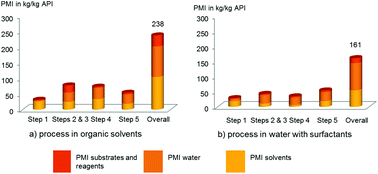Surfactant technology applied toward an active pharmaceutical ingredient: more than a simple green chemistry advance
Abstract
During our evaluation of the potential of surfactant technology, we rapidly experienced a straightforward and highly advantageous technology, which we applied on-scale. This resulted into significant benefits across our entire synthetic route, not just from an environmental standpoint but also from an economic and productivity perspective. To name a few: reduction of organic solvent use, reduction of water use, reduction of metric such as PMI, reduction of cost, reduction of cycle time, milder reaction conditions, improved yields, and improved process performances. Quantatively, the differences for some of these virtues approached 50% in favor of surfactant technology, all of which realised in multi-purpose facilities already within the infrastructure of standard pharmaceutical or chemical organizations. All of these benefits were achieved using a catalytic amount of a nonionic designer surfactant (e.g. TPGS-750-M) in water instead of traditional organic solvents.


 Please wait while we load your content...
Please wait while we load your content...